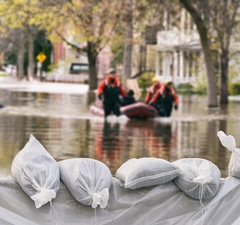
Flooding can be inevitable depending on where you live, but there are steps you can take to minimize or possibly prevent flood damage to your property.
- Install standpipes or backflow valves to prevent sewer lines from backing up.
- Put in a floodwall or shield.
- Use concrete blocks to lift up your washer, dryer, water heater, oil tank, furnace, and electrical wiring.
Install a sump pump system if you have a basement and/or other below-grade floors. - Plan your landscape to include plants and vegetation that resist soil erosion. For best results, try planting:
- Ornamental grasses (like mondo, yellow foxtails, and blue fescue) are the best at fighting soil erosion.
- Ground covers and shrubs are also a great way to block foot traffic that causes soil erosion.
- Trees. Any trees!
- Install a flood detection device in your basement. The best models have alarms and/or can call your phone if it senses water intrusion.
- Store important documents and special family keepsakes and heirlooms in areas other than the basement.
What to Do During a Flood
Floods can be pretty scary, but stay calm and focus on keeping your family safe. If time allows:
- Turn off the main power switch.
- Sanitize your bathtub and all sinks, then fill them with clean water in case your water supply becomes contaminated.
- If rising water is making you feel threatened, leave your home or move to upper floors.
- DO NOT TRY TO DRIVE DURING A FLOOD. You can lose control or stall in just 6 inches of water. If you are in your car when water is rising quickly, get out of your car immediately and move to higher ground.
- Stay away from fallen power lines.
- DO NOT TRY TO TRAVEL THROUGH A FLOOD. Remember the 6-inch rule:
- Just 6 inches of water can stall your car or cause you to lose control if you are driving.
- Just 6 inches of water can sweep you away if you try walking through a flood.
What to Do After a Flood
- Check the house for structural damage before entering.
- Use a flashlight, and not a lighter, matches, or a candle if it’s dark.
- Check with your local news or municipalities to ensure when water is safe to drink and bathe in again.
- Have an electrician inspect your system before turning your power on to make sure it’s safe.
- Get started on your claims:
- Take photos with your cell phone or a camera.
- Take inventory of your damaged or destroyed items.
- Document all of your damage.
- Report your claim to your insurance agent as soon as possible.
- Call RestoreMore because we specialize in post-flood cleanup!